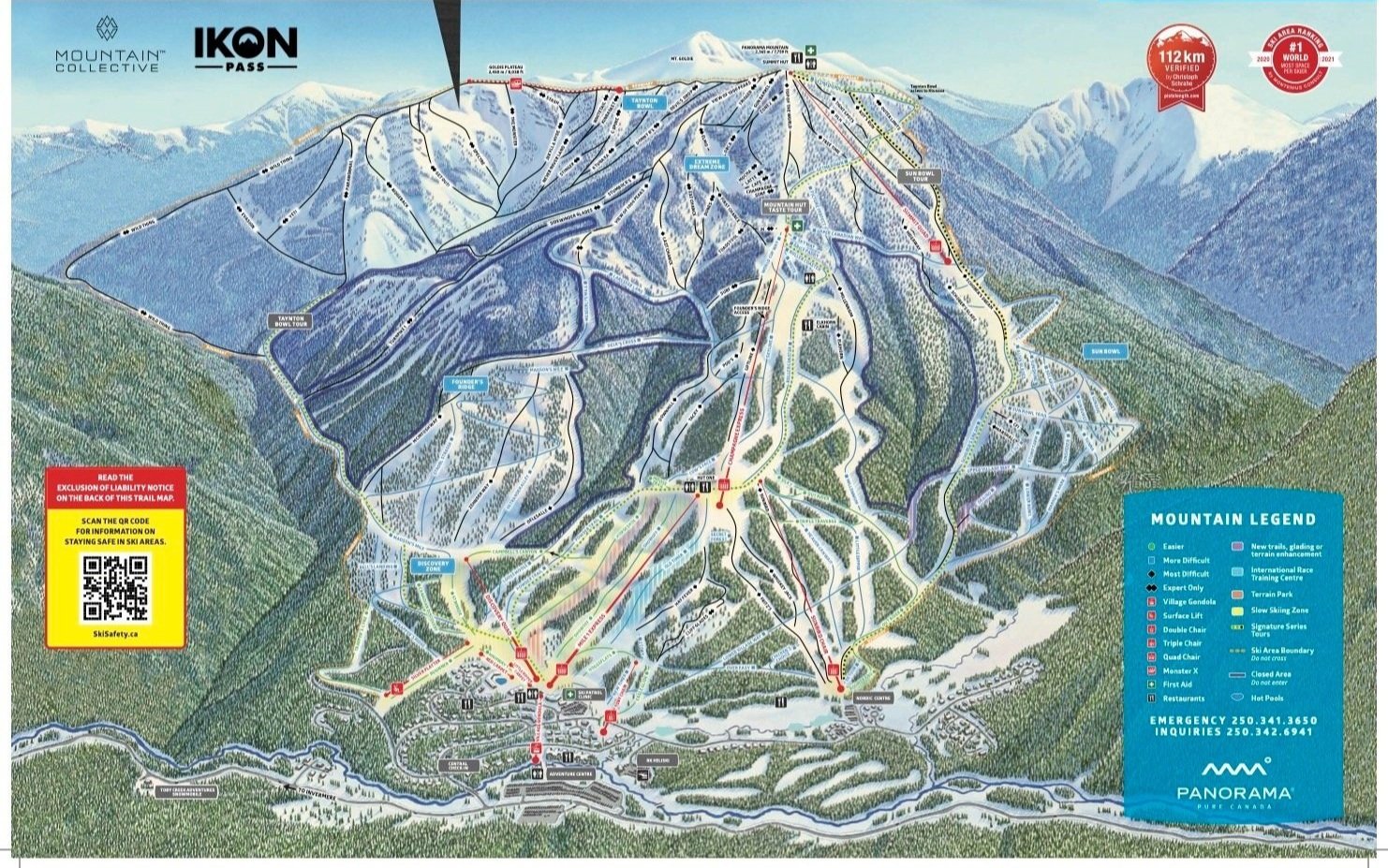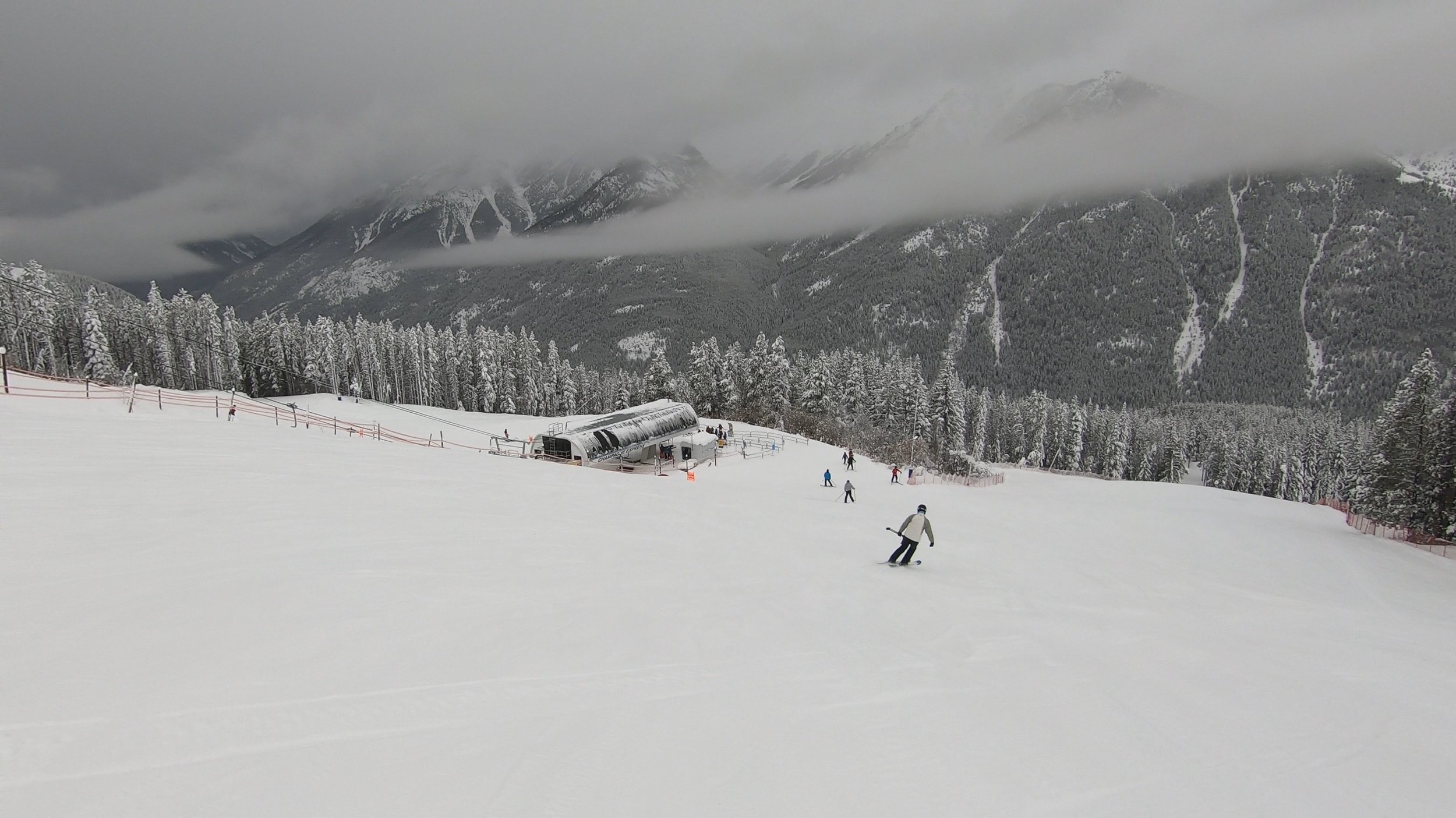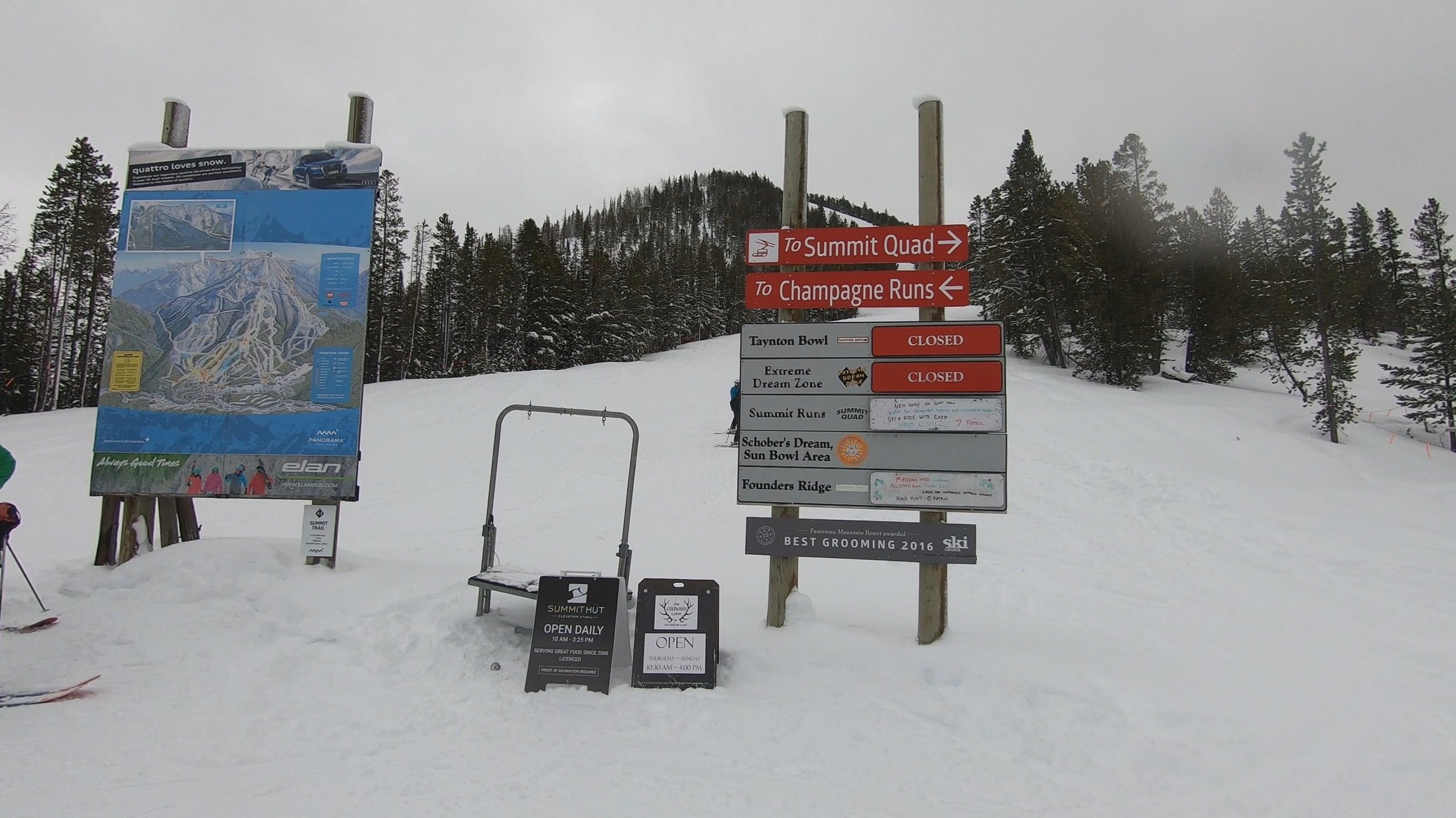MOUNTAIN SCORE
CATEGORY BREAKDOWN
See our criteria8
Snow:
6
Resiliency:
8
Size:
8
Terrain Diversity:
7
Challenge:
5
Lifts:
7
Crowd Flow:
5
Facilities:
6
Navigation:
9
Mountain Aesthetic:
GOOD TO KNOW
1-Day Ticket: $111-$118 USD ($146-$156 CAD)
Pass Affiliation: Ikon, Mountain Collective
On-site Lodging: Yes
Aprés-ski: Limited
Nearest Cities: Calgary (3.5 hrs), Spokane (5.5 hrs), Kelowna (5.5 hrs)
Recommended Ability Level:
+ Pros
Incredible vertical drop
Stunning surroundings
Strong lift-served snow preservation
Available backcountry-like snowcat experience
– Cons
Lower snowfall than other mountains
Narrow footprint
Small on-mountain facilities
Difficult to lap certain areas
MOUNTAIN STATS
Lifts: 10
Trails: 135
Beginner: 15%
Intermediate: 35%
Advanced/Expert: 50%
Mountain Review
Hidden in the remote ranges of the Purcell Mountains, Panorama offers a destination alternative to better-known mountains elsewhere on Canada’s famed Powder Highway. The resort has gained popularity in recent years with its addition to the Mountain Collective and Ikon Passes, and it stands out with an impressive vertical drop, incredible views, and some of the most untouched lift-served terrain in the region. But Panorama faces some stiff competition, and would-be guests should heed a few circumstances before booking a trip here.
Resort Layout
Panorama’s biggest asset is its vertical descent. The resort’s 4,265-foot (1300-meter) drop is one of the longest on the continent, taking three different lifts to fully conquer and resulting in some incredibly long runs. And unlike some resorts, such as Revelstoke and Sunshine Village, all of Panorama’s terrain elevations boast plentiful trail options, with a solid mix of trails across lower, mid, and upper-mountain elevations.
Panorama’s 4,265-foot drop is one of the longest in North America—and it comes with views to match.
However, Panorama’s amazing vert comes paired with a fairly narrow footprint—at least from a practical standpoint. There’s really only one zone of lappable trails in each of the mid- and upper-elevations, and one or two zones in the lower mountain, depending on who you ask. This means that while there’s plenty of different elevations of terrain to choose from, the options in each tier of elevation are somewhat limited as far as destination resorts go. Panorama’s far reaches do offer some notably distinctive terrain zones, but they’re not exactly easy to spend time in, taking two—or in extreme cases, three—lifts to lap. These isolated terrain pods make for insanely long laps and require steadfast endurance, but they offer excellent snow preservation and, when conditions are good, make for some of the best lift-served powder runs in the region.
Panorama often sees high-quality snow, although accumulation can be spotty.
Snow Quality
Speaking of powder, Panorama often sees high-quality snow but varying conditions across different elevation tiers. Accumulation is typically dry and light, but the resort doesn’t see quite the same quantity of snow as many Canadian Rockies competitors. In addition, while Panorama’s upper-mountain snow totals can sometimes dwarf that of base elevations, the upper third of the mountain entirely lacks snowmaking. Finally, while Panorama generally sees cold temperatures throughout the core winter, it occasionally experiences rain events, especially in lower elevations. These factors make Panorama less dependable, especially for an early-season trip, than one might expect.
TRAIL MAP
Beginner Slopes
Panorama’s beginner footprint is limited. The resort’s green terrain sits entirely within the bottom third of the mountain, and even in these lower resort areas, trail options are slim, with only one or two green runs off each lift. But while it might not be the best mountain for lower-level progression, Panorama’s bunny hill setup actually isn’t half bad, with two dedicated learning lifts and three magic carpets near the main base.
While Panorama’s beginner slopes are limited, the resort is home to an array of stunning intermediate cruisers.
Intermediate Slopes
Guests will begin to truly appreciate Panorama at the intermediate level. Guests of this proficiency will find winding cruisers across all elevations, and especially in mid-mountain areas. These runs offer incredible vistas of the surrounding mountains that are worthy of the resort’s name. Panorama’s isolated Founder’s Ridge and Sun Bowl areas offer uniquely long and isolated groomers that are hard to come by at other mountains. However, it’s worth noting that some of Panorama’s blues are harder than others, with a few runs—chiefly in these isolated areas—remaining ungroomed throughout the winter.
Panorama’s advanced and expert terrain exists in its outermost and uppermost regions.
Advanced and Expert Slopes
Visitors will get the most out of Panorama at the advanced and expert level. The resort’s toughest terrain exists in both its uppermost and outermost regions. The Summit Quad serves a range of single-black mogul and modestly-spaced glade runs, while some fairly tight expert-level trees exist within the Outer Limits trail. Just across the ridge from these advanced trails exists Panorama’s Extreme Dream zone, which hosts lightly-gladed but very steep double-black runs. These trails are notably long and technical in pitch, with some gnarly cliffs hidden throughout. And finally, one more ridge over from Extreme Dream exists Panorama’s Taynton Bowl, which hosts what’s probably the most technical terrain at the resort. While not quite up to the world-class extreme caliber of some Canadian Rockies competitors, Taynton features terrain with high-consequence entries that’s even a bit more cliff-riddled than Extreme Dream.
RECOMMENDED SKIS FOR PANORAMA
NOTE: We may receive a small affiliate commission if you click on the below links. All products listed below are unisex.
Recommended intermediate ski
Recommended advanced ski
Recommended glade ski
Recommended powder ski
Perhaps Panorama’s most beautiful trail, View of 1000 Peaks, forms the ridgeline between the Extreme Dream and Taynton Bowl zones. This single-black trail is steeply pitched, but it offers almost dreamy views of the resort and surrounding mountaintops on clear days. If you’re looking for a world-class challenge in endurance, be sure to check out the Stumbock’s and Turnpike 1 trails off of View of 1000 Peaks—these trails form a continuous advanced-to-expert terrain line that spans more than two thirds of the resort’s vert, and will give even the most tenured skiers and riders a run for their money.
Hike-to Terrain
The outermost reaches of Panorama’s Taynton Bowl terrain are not directly lift served, requiring hiking to reach. These zones also see service from a paid snowcat Thursday through Sunday between January and March, conditions permitting. But while difficult to get to, these Taynton runs can hold untouched powder for days, offering some of the most backcountry-like in-bounds terrain at any North American ski resort without the same avalanche risks as out-of-bounds slopes.
Panorama offers paid snowcat service to non-lift-served expert terrain on select weekends and holidays.
On-Mountain Resiliency
Panorama’s toughest terrain zones face the resort’s toughest opening schedules. The Taynton Bowl takes quite a bit of snow to fill in, and this isolated area can remain closed well into January depending on the season. In addition, while Panorama’s glade zones hold snow well, they can become crusty or icy after long periods with no new accumulation—especially on the southeast-facing slopes off the Summit lift.
Only 40% of the resort includes snowmaking, and the areas that don’t—including the whole upper mountain—can be tough bets for early season trips.
Some of Panorama’s trails can be tough bets for the early season. The pictured sign, captured in December 2022, warns of several closed advanced and expert zones.
Terrain Parks
Panorama offers a modest terrain park presence, but it’s not a defining characteristic of the mountain. The resort often sets up enjoyable boxes, rails, and jumps ranging from small to large, typically off the Mile 1 chair, but other destinations offer more dedicated freestyle setups.
Lifts
Panorama’s narrowness especially manifests in its lift setup. The resort has essentially no redundancies, with only two lifts up to mid-mountain—the Mile 1 Express from the main base, and the Sunbird triple from the satellite Nordic Centre base—and just one lift each serving the mid-mountain and upper-mountain areas.
The limited uphill infrastructure results in certain terrain pods not having any direct lift service and requiring multiple lifts to lap. However, Panorama’s remote, difficult-to-reach location keeps crowds to the point where uphill capacity isn’t a huge issue; lines really only build up at the Summit lift on peak days with good snow conditions. On the other hand, the resort could do a better job of warning guests when they won’t be able to get back to a certain lift, and it’s pretty easy to end up further down than intended or at the wrong base.
Panorama offers a mix of high-speed and slow lifts.
Panorama guests should generally find themselves satisfied with the lift rides themselves, with the Mile 1 and Champagne Express chairs providing high-speed service to the bottom two-thirds of the mountain. Panorama’s other lifts, including the Summit Quad and Sunbird chair, are slow, but they’re either not too long (in the case of the former) or pretty easy to avoid (in the case of the latter).
It’s also worth noting that the so-called Panorama Gondola, which technically doesn’t serve any terrain but provides transportation between the main base and the primary parking lot, is actually an open-cabin pulse cabriolet. The lift’s low capacity may impact wait times at the beginning and end of the day.
RECOMMENDED SNOWBOARDS FOR PANORAMA
NOTE: We may receive a small affiliate commission if you click on the below links. All products listed below are unisex.
Recommended intermediate board
Recommended advanced board
Recommended expert board
Recommended powder board
Facilities
If you want to stop in for a break, Panorama’s on-mountain lodges are fairly decent but not up to the standards of some mountains. Three huts exist above the main base; two in the mid-mountain, and one at the top. These lodges offer incredible views, but they’re all pretty small, and seating can be hard to come by on the busiest days.
Panorama’s Summit Hut offers incredible views but isn’t the biggest lodge out there.
Getting There
Panorama is located in an incredibly remote area. The resort is approximately three-and-half hours from Calgary, but drives can be much longer than that depending on road conditions. The resort is also about five-and-a-half hours from both Kelowna, British Columbia and Spokane, Washington.
Traffic is rarely an issue, and while Panorama’s main parking lots can fill up, the overflow lots are easily accessible from the Panorama Gondola. However, Panorama’s access road can get especially sketchy during the peak winter months, with a long, remote, and dangerous 12-mile (20 km) stretch required to reach the mountain. For those hoping to avoid driving altogether, Panorama offers a handful of shuttle services to and from both the Calgary airport and Banff. However, these services are pricey, costing over $150 CAD per adult one way.
Panorama’s 12-mile access road suffers from poor conditions during the winter months and can be very scary to drive.
Lodging
Despite its remote location, Panorama offers an array of lodging accommodations on-site. The resort hosts several hotels and condos ranging from upscale to luxury. All of these accommodations either offer direct ski-in/out access or sit within walking distance of the Panorama Gondola.
None of Panorama’s on-site lodges are particularly cheap, but plenty of more economical options exist about 30 minutes away in the town of Invermere.
Aprés-ski
Panorama offers much more of a family-friendly environment than a party atmosphere, but the resort does feature some unique activities that are hard to come by elsewhere. While post-slopes bars are on the mellower side, they do feature cordial vibes—and given Panorama’s remote location, can attract some really interesting clientele.
Perhaps the coolest part about visiting Panorama besides the skiing itself is the resort’s hot pools. The Panorama Springs Pools comprise one warm pool and two hot tubs, and they offer incredible slopeside relaxation after a long day on the mountain. However, these pools do have one major catch—they’re only available for overnight lodging guests.
Panorama’s base village hosts an array of on-site lodging, bars, and post-slopes activities such as hot pools.
Verdict
Panorama’s impressive vertical drop and stunning surroundings give it a ton of character, but it may not offer quite as well-rounded of an overall mountain experience as some competitors. The resort is probably a bit too remote to justify the travel for a typical fly-to vacationer, but for those who happen to be on a Powder Highway road trip, it’s well worth a stop—assuming it’s been a good snow year.
Pricing
Lift tickets top out at $166 CAD ($125 USD with current exchange rates), making the resort a good value for the quality of slopes it offers.


























